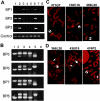Molecular basis of clonal expansion of hematopoiesis in 2 patients with paroxysmal nocturnal hemoglobinuria (PNH)
- PMID: 16940417
- PMCID: PMC1895453
- DOI: 10.1182/blood-2006-05-025148
Molecular basis of clonal expansion of hematopoiesis in 2 patients with paroxysmal nocturnal hemoglobinuria (PNH)
Abstract
Somatic mutation of PIGA in hematopoietic stem cells causes deficiency of glycosyl phosphatidylinositol-anchored proteins in paroxysmal nocturnal hemoglobinuria (PNH) that underlies the intravascular hemolysis but does not account for expansion of the PNH clone. Immune mechanisms may mediate clonal selection but appear insufficient to account for the clonal dominance necessary for PNH to become clinically apparent. Herein, we report 2 patients with PNH whose PIGA-mutant cells had a concurrent, acquired rearrangement of chromosome 12. In both cases, der(12) had a break within the 3' untranslated region of HMGA2, the architectural transcription factor gene deregulated in many benign mesenchymal tumors, that caused ectopic expression of HMGA2 in the bone marrow. These observations suggest that aberrant HMGA2 expression, in concert with mutant PIGA, accounts for clonal hematopoiesis in these 2 patients and suggest the concept of PNH as a benign tumor of the bone marrow.
Figures



Similar articles
-
The pathophysiology of paroxysmal nocturnal hemoglobinuria.Exp Hematol. 2007 Apr;35(4):523-33. doi: 10.1016/j.exphem.2007.01.046. Exp Hematol. 2007. PMID: 17379062 Review.
-
Deregulated expression of HMGA2 is implicated in clonal expansion of PIGA deficient cells in paroxysmal nocturnal haemoglobinuria.Br J Haematol. 2012 Feb;156(3):383-7. doi: 10.1111/j.1365-2141.2011.08914.x. Epub 2011 Oct 24. Br J Haematol. 2012. PMID: 22017592
-
Insights Into the Emergence of Paroxysmal Nocturnal Hemoglobinuria.Front Immunol. 2022 Jan 28;12:830172. doi: 10.3389/fimmu.2021.830172. eCollection 2021. Front Immunol. 2022. PMID: 35154088 Free PMC article. Review.
-
Clinical paroxysmal nocturnal hemoglobinuria is the result of expansion of glycosyl-phosphatidyl-inositol-anchored protein-deficient clone in the condition of deficient hematopoiesis.Int J Hematol. 2001 Jan;73(1):64-70. doi: 10.1007/BF02981904. Int J Hematol. 2001. PMID: 11372757
-
A new aspect of the molecular pathogenesis of paroxysmal nocturnal hemoglobinuria.Hematology. 2002 Aug;7(4):211-27. doi: 10.1080/1024533021000024094. Hematology. 2002. PMID: 14972783 Review.
Cited by
-
Complement and inflammasome overactivation mediates paroxysmal nocturnal hemoglobinuria with autoinflammation.J Clin Invest. 2019 Dec 2;129(12):5123-5136. doi: 10.1172/JCI123501. J Clin Invest. 2019. PMID: 31430258 Free PMC article.
-
Long noncoding RNA FAM157C contributes to clonal proliferation in paroxysmal nocturnal hemoglobinuria.Ann Hematol. 2023 Feb;102(2):299-309. doi: 10.1007/s00277-022-05055-8. Epub 2023 Jan 6. Ann Hematol. 2023. PMID: 36607351 Free PMC article.
-
Deep sequencing reveals stepwise mutation acquisition in paroxysmal nocturnal hemoglobinuria.J Clin Invest. 2014 Oct;124(10):4529-38. doi: 10.1172/JCI74747. Epub 2014 Sep 17. J Clin Invest. 2014. PMID: 25244093 Free PMC article.
-
Paroxysmal nocturnal hemoglobinuria induced by the occurrence of BCR-ABL in a PIGA mutant hematopoietic progenitor cell.Leukemia. 2016 May;30(5):1208-10. doi: 10.1038/leu.2015.268. Epub 2015 Oct 6. Leukemia. 2016. PMID: 26437783 No abstract available.
-
Paroxysmal nocturnal hemoglobinuria and concurrent JAK2(V617F) mutation.Blood Cancer J. 2012 Mar;2(3):e63. doi: 10.1038/bcj.2012.7. Epub 2012 Mar 23. Blood Cancer J. 2012. PMID: 22829258 Free PMC article. No abstract available.
References
-
- Takeda J, Miyata T, Kawagoe K, et al. Deficiency of the GPI anchor caused by a somatic mutation of the PIG-A gene in paroxysmal nocturnal hemoglobinuria. Cell. 1993;73: 703-711. - PubMed
-
- Miyata T, Takeda J, Iida Y, et al. The cloning of PIG-A, a component in the early step of GPI-anchor biosynthesis. Science. 1993;259: 1318-1320. - PubMed
-
- Kawagoe K, Kitamura D, Okabe M, et al. Glycosylphosphatidylinositol-anchor-deficient mice: implications for clonal dominance of mutant cells in paroxysmal nocturnal hemoglobinuria. Blood. 1996;87: 3600-3606. - PubMed
Publication types
MeSH terms
Substances
Grants and funding
LinkOut - more resources
Full Text Sources
Other Literature Sources
Medical

